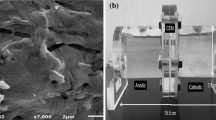Abstract
The effect of applied DC potentials on the bioleaching of a chalcopyrite concentrate in the presence of Acidithiobacillus ferrooxidans is discussed. Copper dissolution was the highest at an applied potential of +600mV (SCE), while all the dissolved copper got cathodically deposited at a negative potential of −600mV (SCE). Electrobioleaching at an applied potential of +600mV (SCE) was established at different pulp densities as a function of time. The effect of applied potentials and electrolytic currents on the activity and growth of bacterial cells was assessed. Preadaptation of bacterial cells to the concentrate slurry and electrolytic growth conditions significantly enhanced copper dissolution. Electrochemical and biochemical mechanisms involved in electrobioleaching are illustrated with respect to oxidative dissolution and biocatalysis of anodic oxidation.
Similar content being viewed by others
References
Abhakumari, 1996, “Electrobioleaching of chalcopyrite flotation concentrate,” Masters Thesis. Indian Institute of Science, Bangalore, India, p. 173.
Ali Ahmadi, A., Schaffie, M., Petersen, J., Schippers, A., and Ranjbar, M., 2010, “Electrochemical bioleaching of high grade chalcopyrite flotation concentrates in a stirred bioreactor,” Hydrometallurgy, 104, pp. 99–105.
Ali Ahmadi, A., Schaffie, M., Petersen, J., Schippers, A., and Ranjbar, M., 2011, “Conventional and electrochemical bioleaching of chalcopyrite concentrates by moderately thermophilic bacteria at high pulp density,” Hydrometallurgy, 106, pp. 84–92.
Biegler, T. and Constable, D.C., 1977, “Continuous electrolytic reduction of a chalcopyrite slurry,” Journal of Applied Electrochemistry, 7, pp. 175–179.
Chirpa Selvi, S. and Natarajan, K.A., 1998, “Electrobioleaching — A novel concept for processing complex sulphide ores,” Transactions Indian Institute of Metals, 51, pp. 17–26.
Devasia, P., Natarajan, K.A., Sathyanarayana, D.N., and Ramananda Rao, G., 1993, “Surface chemistry of Thiobacillus ferrooxidans relevant to adhesion on mineral surfaces,” Applied Environmental Microbiology, 59, pp. 4051–4055.
Fuentes-Aceituno, J.C., Lapidus, G.T., and Doyle, FM., 2008, “A Kinetic study of the electro-assisted reduction of chalcopyrite,” Hydrometallurgy, 92, pp. 26–33.
Gamboa, G. V., Vasquez, B. R., and Dixon, D. G., 2006, “The active to passive transition of chalcopyrite,” ECS Transactions, 2(3), pp. 165–175.
Jyothi, N., Sudha, K.N., and Natarajan, K.A., 1989, “Electrochemical aspects of selective bioleaching of sphalerite and chalcopyrite from mixed sulphides,” International Journal of Mineral Processing, 27, pp. 189–203.
Lara, R.H., Meza, J.V.G., Gonzalez, I., and Cruz, R., 2013, “Influence of the surface speciation on biofilm attachment to chalcopyrite by Acidithiobacillus thiooxidans,” Appl. Microbiol., Biotechnol., 97, pp. 2711–2724.
Li, A. and Huang, S., 2011, “Comparison of the electrochemical mechanism of chalcopyrite dissolution in the absence and presence of Sulfolobus metallicus at 700C,” Minerals Engineering, 24, pp. 1520–22.
Natarajan, K.A., 1992a, “Bioleaching of sulphides under applied potentials,” Hydrometallurgy, 29, pp. 161–172.
Natarajan, K.A., 1992b, “Effect of applied potentials on the activity and growth of Thiobacillus ferrooxidans,” Biotechnology and Bioengineering, 39, pp. 907–913.
Natarajan, K.A., 1992c, “Electrobioleaching of base metal sulphides,” Met. Transaction B, 1992, 23B, pp. 5–11.
Natarajan, K.A., Reimer, S.C., Iwasaki, I., and Reid, K.J., 1985, “Electroleaching studies on selective nickel dissolution from a bulk copper-nickel concentrate,” Proceedings 15th International Mineral Processing Congress Cannes, France, 2, pp. 413–423.
Selvi, S.C., Modak, J.M., and Natarajan, K.A., 1998, “Electrobioleaching of sphalerite flotation concentrate,” Minerals Engineering, 11, pp. 783–788.
Silverman, M.P and Lundgren, D.G., 1959, “Studies on the chemoautotrophic iron bacteria Ferrobacillus ferrooxidans: an improved medium and a harvesting procedure for securing high cell yields,” Journal of Bacteriology, 77, pp. 642–647.
Vasquez, B.R., Gamboa, G.V., and Dixon, D.G., 2012, “Transpassive electrochemistry of chalcopyrite micro-particles,” J. Electrochem. Soc., 159, pp. C18–C14.
Wiertz, J.V., Moya, P., Sanhueza, A., and Vargas, T., 1994, “Influence of substrate polarization on the activity of Thiobacillus ferrooxidans in bioleaching,” Hydrometallurgy-94 Inst. Min & Met, Springer, pp. 395–405.
Author information
Authors and Affiliations
Corresponding author
Additional information
Paper number MMP-13-054.
Discussion of this peer-reviewed and approved paper is invited and must be submitted to SME Publications Dept. prior to May 31, 2015.
Rights and permissions
About this article
Cite this article
Natarajan, K.A., Kumari, A. Role of applied potentials on bioleaching of chalcopyrite concentrate and growth of Acidithiobacillus ferrooxidans. Mining, Metallurgy & Exploration 31, 215–222 (2014). https://doi.org/10.1007/BF03402473
Received:
Accepted:
Published:
Issue Date:
DOI: https://doi.org/10.1007/BF03402473



